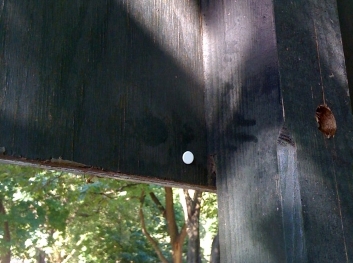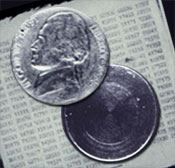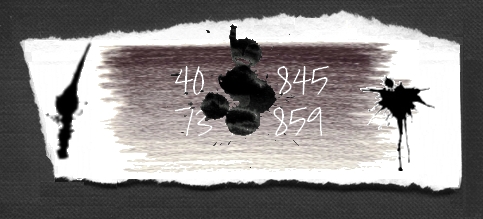The posted coordinates do not lead to the final container. They lead to a sign for the bridle path behind Tavern on the Green, used as a signal site. A red thumbtack means safe arrival. A white thumbtack means you're being watched. To save you a visit, I've taken a photo [gasp!]:

If you thought the Cold War was over, you were wrong.
The Russian spy ring broken up this summer proves that. The arrests come at the 50th anniversary of one of our country's most high profile Cold War victories - the Supreme Court's affirmation of Rudolf Ivanovich Abel's conviction as a Soviet spy. Although the case isn't as closed as we thought it was...
You may know him as Rudolf Abel. We knew him as Abel, Vilyam Fisher, "Mark", Martin Collins, Emil Goldfus, Andrew Kayotis, and many other aliases that were never made public (and who knows how many Abel took to his grave). Abel treated New York as his personal playground of espionage, leaving brilliant custom containers and coded messages from Brooklyn to the Bronx with bold impunity. For nearly a full decade his network of spies stretched from New York to Virginia, to Los Alamos, to California, to Mexico, to Brazil, to Argentina, and beyond - Abel was the Soviet Union's number one spy in the United States, the KGB's best, and he controlled the entire network from his artist's studio in Cadman Plaza.
Abel's gifts as a field operative kept him out of our hands for years - until a newsboy for the Brooklyn Eagle inadvertently intercepted a message between Abel's team and Moscow, hidden in a remarkable container.

The morning that Abel was arrested, he was observed by our agents acting far differently than usual. The surveillance reports indicate that he seemed excessively nervous, and he changed his normally predictable routine. He left his Brooklyn studio hours earlier than usual, and led our agents on a complicated, evasive path through several different boroughs, by taxi, train and on foot. After a visit to the 81st Street subway station - a location where Abel was known to leave chalk marks indicating a dead drop had gone "live" - he was observed furiously scribbling a series of numbers on his way back to the Hotel Latham, where he rented a room under one of his many aliases.
Abel had never acted so recklessly before, penning an obviously sensitive message in public view - he was panicking. Our agents moved in immediately and arrested him in his room before he could flee or destroy any evidence.
The message he had been scribbling was never found. Nor were a pair of small fake rock containers Abel had been spotted with in the morning. Abel's chalk mark at the subway station signal site indicated that a particular dead drop elsewhere had gone live, but after scouring that location thoroughly our agents came away with nothing. (Although it would be impossible for any chalk marks to survive for half a century, luckily the agency has these file photos from the morning of Abel's arrest.)
File photos from 81st Street subway station, 21 June 1957
But we still had more than enough to bring Abel to justice, and a chapter in Cold War espionage was closed forever.
Or so we thought. This month we have been reviewing past case files in the wake of the recently arrested Russian spies. A large box of Abel documents was dropped, spilling papers and equipment everywhere. As we cleaned up, one item in particular made my heart stop. A small screw bolt that had been in Abel's pocket when he was arrested had shattered on impact with the ground. It was hollow, and amidst the broken pieces was a tightly wound roll of paper.

The false nail had somehow been overlooked by our arresting agents, and as I unrolled the scrap, I realized I held in my hands the message Abel had been scribbling that fateful morning. A quick glance at the number frequencies and spacings told me that Abel clearly had not had time to fully encrypt his message, which filled me with a mixture of excitement and dread:

I hurriedly tore through the rest of the file contents hoping to learn how to unlock Abel's mind that day. One report said that Abel often used his Cadman Plaza apartment number as a secondary key for Mod 10 Addition, and a feeling of hope choked its way up to my throat. So if I could just find the primary encryption block...
But my heart sank when I found the scattered remains of a folder marked "Snowfal Code". One of Abel's false pens had apparently exploded when the box fell, spraying ink all over many of the documents. The page I had been searching for, a scrap of paper that had been in Abel's possession when he was arrested, didn't survive unscathed. A series of letters and numbers in a "straddling checkerboard" pattern - it must be the key to decrypting Abel's scribbling... but it's been ruined by the ink.

Without the keyword data on the first line, the grid is useless for decryption. I tried everything to see through the smudges, but my efforts have been nearly useless. I say nearly, because although I haven't been able to tease out the obscured areas of the grid, as I held it up to the light I noticed some impressions on the back. Using a technique from childhood, with the flat of my pencil I teased out a few additional numbers that have apparently gone unnoticed for fifty years. The paper was too fragile to read where the ink had soaked through, but I believe I captured most of what was there.

More numbers - but what do they mean? Are they the key to why our men found nothing at the dead drop over 50 years ago? Did Abel move the dead drop? Why was this folder labeled the "Snowfal Code"? (For that matter, why "snowfal" and not "snowfall"?) Why was Abel, the most accomplished Soviet spy of his era, so unnerved on that fateful day in 1957?
What was he trying to protect?
Early finders will receive a set of Soviets stamps honoring KGB spies - including this guy.
Although much of The Spy of Cadman Plaza can be solved from home, there is one point at which you will need to visit New York in order to advance (the Dead Drop). For cachers with a base of activity far from the city, there is a workaround that others have taken advantage of - please contact me for details.